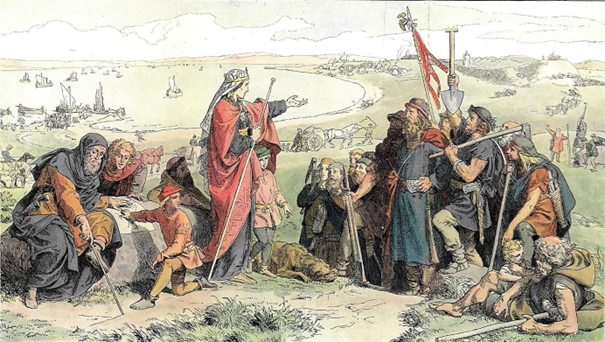EDITORIAL NOTE
Abstract
Cover image: Thyre Dannebod grundlægger Dannevirke (Thyra Dannebod establishes the Danevirke), Lorenz Frølich, 1855. Color illustration for the fourth edition of the 1914 book Illustreret Danmarkshistorie for Folket (Illustrated history of Denmark for the people, original black and white).
In 2023, Queen Thyra once again became the focal point of Viking Age researchers. An ongoing interdisciplinary investigation has unveiled several novel insights into the renowned queen, particularly in relation to the Jelling II runestone (DR 42, 10th century AD) and other runestones. Runologist Lisbeth Imer, in collaboration with archaeologists Kitzler Åhfeldt and Henrik Zedig, employed 3D typology research to ascertain that the master carver of the Jelling runestones, as well as those from Læborg and Bække in southern Jutland, was Ravnunge-Tue. The identification of the individual responsible for the inscriptions was achieved through a comparative analysis of the shape, depth, and language of various runestones. Additionally, the presence of the name "Thyra" in the latter two runestones solidified her identity as the wife of King Gorm, the father of Harald Bluetooth—the inaugural unifier and principal Christianizer of Denmark. These research findings were officially published in October 2023 (Imer; Åhfeldt; Zedig, 2023, pp. 1262-1278).
Downloads

##submission.downloads##
Pubblicato
Fascicolo
Sezione
Licenza
The author (s) of the original submitted undertake to comply with the following:
- All authors are publicly responsible for it.
- The authors claim that this original is their own and that they assume full responsibility to third parties, whether moral or patrimonial, by reason of its content, stating that the work does not infringe any intellectual property rights of third parties.
- The author (s) agree to the copyrights of the original to Scandia Journal, to which they grant permission for its reproduction, editing and online publication.
- The author (s) grant their copyright of their original to the Scandia Journal, licensed under the Creative Commons Attribution License, which allows the sharing of this work with the acknowledgment of their authorship.
- The author (s) have permission and are encouraged to cite and distribute their original.

